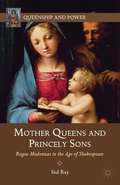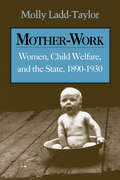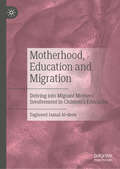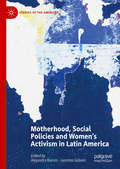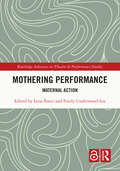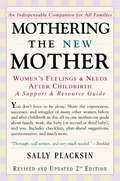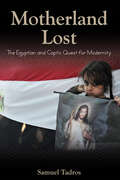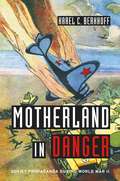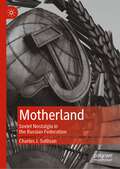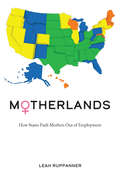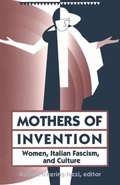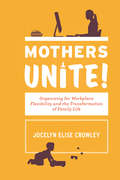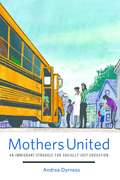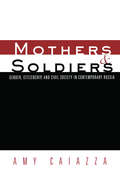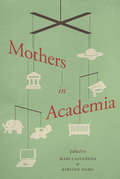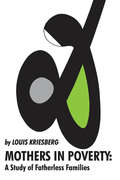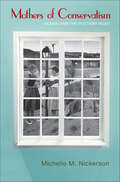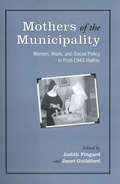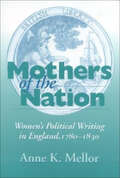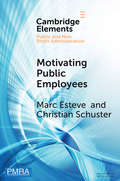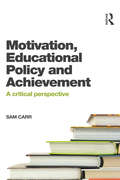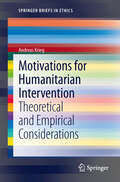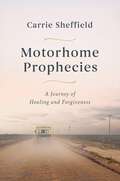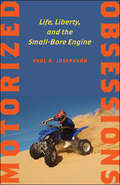- Table View
- List View
Mother Queens And Princely Sons
by Sid RayThis study explores representations of the Madonna and Child in early modern culture. It considers the mother and son as a conceptual, religio-political unit and examines the ways in which that unit was embodied and performed. Of primary interest is the way mothers derived agency from bearing incipient rulers. By focusing on agency and authority, the book traces a pattern between the symbiotic unity of Madonna and Child and other influential, dimorphic concepts, what author Sid Ray calls 'accolated bodies, ' in early modern thought: the king's two bodies, marital coverture, and the doctrine of the hypostatic union of man and God in Christ, each with its variation on how the two bodies in question share authority. Attuned to Catholic historical and cultural reverberations of the Madonna and Child and debates about the origins of power, this book reassesses the mother-son unit, focusing on its inversion of conventional gender roles and potential to destabilize and redefine the ways in which gender and power operate. Ultimately, the book argues that representations of the mother-son unit contested Protestant patriarchal authority by offering meritocratic and egalitarian alternatives to established models of governance.
Mother-Work: Women, Child Welfare, and the State, 1890-1930 (Women, Gender, and Sexuality in American History)
by Molly Ladd-TaylorEarly in the twentieth century, maternal and child welfare evolved from a private family responsibility into a matter of national policy. Molly Ladd-Taylor explores both the private and public aspects of child-rearing, using the relationship between them to cast new light on the histories of motherhood, the welfare state, and women's activism in the United States. Ladd-Taylor argues that mother-work, "women's unpaid work of reproduction and caregiving," motivated women's public activism and "maternalist" ideology. Mothering experiences led women to become active in the development of public health, education, and welfare services. In turn, the advent of these services altered mothering in many ways, including the reduction of the infant mortality rate.
Motherhood, Education and Migration: Delving into Migrant Mothers’ Involvement in Children’s Education
by Taghreed Jamal Al-deenThis book draws together analysis of class, gender, ethnicity and processes of migration in the context of family-school relationships. It provides an original analysis of the role of class as gendered and ethnicised in the explanation of the reproduction of educational inequalities. This book’s analysis of class is developed through insights into how class, gender, ethnicity and religion are interrelated and connected to patterns of advantages and disadvantages in transnational flows. It explores parental involvement in children’s education in the migratory context as a key site for the analysis of social class positioning and repositioning, focusing on a group of migrant Muslim mothers living in Australia. This book sheds lights on the interconnection of class, gender, ethnicity and religion embedded in migrant mothers’ lives and the roles of these facets in regard to the education of their children. Delving into Muslim migrant mothers’ practices and beliefs concerning their involvement provides new understanding of how support of children’s education is shaped by the process of migration along with the neoliberal reforms of education systems and in particular repositioning of social class.
Motherhood, Social Policies and Women's Activism in Latin America (Studies of the Americas)
by Jasmine Gideon Alejandra RammThis book is a critical resource for understanding the relationship between gender, social policy and women’s activism in Latin America, with specific reference to Chile. Latin America’s mother-centered kinship system makes it an ideal field in which to study motherhood and maternalism—the ways in which motherhood becomes a public policy issue. As maternalism embraces and enhances gender differences, it has been criticized for deepening gender inequalities. Yet invoking motherhood continues to offer an effective strategy for advancing women’s living conditions and rights, and for women themselves to be present in the public sphere. In analyzing these important relationships, the contributors to this volume discuss maternal health, sexual and reproductive rights, labor programs, paid employment, women miners’ unionization, housing policies, environmental suffering, and LGBTQ intimate partner violence.
Mothering Performance: Maternal Action (Routledge Advances in Theatre & Performance Studies)
by Lena Šimić Emily Underwood-LeeMothering Performance is a combination of scholarly essays and creative responses which focus on maternal performance and its applications from a variety of interdisciplinary perspectives. This collection extends the concept and action of ‘performance’ and connects it to the idea of ‘mothering’ as activity. Mothering, as a form of doing, is a site of never-ending political and personal production; it is situated in a specific place, and it is undertaken by specific bodies, marked by experience and context. The authors explore the potential of a maternal sensibility to move us towards maternal action that is explicitly political, ethical, and in relation to our others. Presented in three sections, Exchange, Practice, and Solidarity, the book includes international contributions from scholars and artists covering topics including ecology, migration, race, class, history, incarceration, mental health, domestic violence, intergenerational exchange, childcare, and peacebuilding. The collection gathers diverse maternal performance practices and methodologies which address aesthetics, dramaturgy, activism, pregnancy, everyday mothering, and menopause. The book is a great read for artists, maternal health and care professionals, and scholars. Researchers with an interest in feminist performance and motherhood, within the disciplines of performance studies, maternal studies, and women’s studies, and all those who wish to gain a deeper understanding of maternal experience, will find much of interest.
Mothering The New Mother: Women's Feelings And Needs After Childbirth - A Support And Resource Guide (Parenting Guides)
by Sally PlacksinFor the expectant and new mom, freshly updated and designed, this acclaimed all-in-one support guide focuses on all aspects of the postpartum experience. The nine chapters in this comprehensive guide include resources, networks, information, stories, and advice to nurture, validate, and empower the new mother, whether she is having her first baby or her third. Among the subjects covered are: what to expect when you go home; what is this period called "postpartum" and how long does it last; where to find breastfeeding help; how to ask for help; homecare options; what are realistic going-back-to-work options; how to relieve the isolation of at-home mothers; what to say (and not to say) to family members. Drawn from three years of research and the author's own experience, each chapter is filled with the practical suggestions and hands-on solutions provided by doctors, nurses, midwives, other caregivers, policymakers, and over 100 new mothers. Also included are many real-life stories told by women in their own voices; checklists; a prenatal and postpartum questionnaire to help assess and plan needs; reading lists; resource listings; and a separate chapter for second-, third-, or more-time moms.
Motherland Lost: The Egyptian and Coptic Quest for Modernity
by Samuel TadrosSamuel Tadros provides a clear understanding of Copts—the native Egyptian Christians—and their crisis of modernity in conjunction with the overall developments in Egypt as it faced its own struggles with modernity. He argues that the modern plight of Copts is inseparable from the crisis of modernity and the answers developed to address that crisis by the Egyptian state and intellectuals, as well as by the Coptic Church and laypeople.
Motherland in Danger
by Karel C. BerkhoffMuch of the story about the Soviet Union’s victory over Nazi Germany has yet to be told. In Motherland in Danger, Karel Berkhoff addresses one of the most neglected questions facing historians of the Second World War: how did the Soviet leadership sell the campaign against the Germans to the people on the home front? For Stalin, the obstacles were manifold. Repelling the German invasion would require a mobilization so large that it would test the limits of the Soviet state. Could the UR marshal the manpower necessary to face the threat? How could the authorities overcome inadequate infrastructure and supplies? Might Stalin’s regime fail to survive a sustained conflict with the Germans? Motherland in Danger takes us inside the Stalinist state to witness, from up close, its propaganda machine. Using sources in many languages, including memoirs and documents of the Soviet censor, Berkhoff explores how the Soviet media reflected-and distorted-every aspect of the war, from the successes and blunders on the front lines to the institution of forced labor on farm fields and factory floors. He also details the media’s handling of Nazi atrocities and the Holocaust, as well as its stinting treatment of the Allies, particularly the United States, the UK, and Poland. Berkhoff demonstrates not only that propaganda was critical to the Soviet war effort but also that it has colored perceptions of the war to the present day, both inside and outside of Russia.
Motherland: Soviet Nostalgia in the Russian Federation
by Charles J. SullivanThis book explores the extent to which and the reasons why Russia’s citizens harbor feelings of nostalgia for the Soviet Union today. Based on the results of a nationwide survey and rigorous field research carried out within several of Russia’s regions, Dr. Sullivan uncovers material and cultural rationales for this sentiment of nostalgia – which poses both an opportunity and a challenge to the Russian government. With Russian nationalism and revanchism a resurgent force in contemporary global affairs, this detailed study will interest scholars of international relations and of populist authoritarianism around the world.
Motherlands: How States Push Mothers Out of Employment
by Leah RuppannerIn the absence of federal legislation, each state in the United States has its own policies regarding family leave, job protection for women and childcare. No wonder working mothers encounter such a significant disparity when it comes to childcare resources in America! Whereas conservative states like Nebraska offer affordable, readily available, and high quality childcare, progressive states that advocate for women’s economic and political power, like California, have expensive childcare, shorter school days, and mothers who are more likely to work part-time or drop out of the labor market altogether to be available for their children. In Motherlands, Leah Ruppanner cogently argues that states should look to each other to fill their policy voids. She provides suggestions and solutions for policy makers interested in supporting working families. Whether a woman lives in a state with stronger childcare or gender empowerment regimes, at stake is mothers’ financial dependence on their partners. Ruppanner advocates for reducing the institutional barriers mothers face when re-entering the workforce. As a result, women would have greater autonomy in making employment decisions following childbirth.
Mothers Of Invention: Women, Italian Fascism, And Culture
by Robin Pickering-IazziMothers Of Invention: Women, Italian Fascism, And Culture
Mothers Unite!: Organizing for Workplace Flexibility and the Transformation of Family Life
by Jocelyn Elise CrowleyIn Mothers Unite!, a bold and hopeful new rallying cry for changing the relationship between home and the workplace, Jocelyn Elise Crowley envisions a genuine, universal world of workplace flexibility that helps mothers who stay at home, those who work part time, and those who work full time balance their commitments to their jobs and their families. Achieving this goal, she argues, will require a broad-based movement that harnesses the energy of existing organizations of mothers that already support workplace flexibility in their own ways.Crowley examines the efforts of five diverse national mothers' organizations: Mocha Moms, which aims to assist mothers of color; Mothers of Preschoolers (MOPS), which stresses the promotion of Christian values; Mothers & More, which emphasizes support for those moving in and out of the paid workforce; MomsRising, which focuses on online political advocacy; and the National Association of Mothers' Centers (NAMC), which highlights community-based networking. After providing an engaging and detailed account of the history, membership profiles, strategies, and successes of each of these organizations, Crowley suggests actions that will allow greater workplace flexibility to become a viable reality and points to many opportunities to promote intergroup mobilization and unite mothers once and for all.
Mothers United: An Immigrant Struggle for Socially Just Education
by Andrea DyrnessIn urban American school systems, the children of recent immigrants and low-income parents of color disproportionately suffer from overcrowded classrooms, lack of access to educational resources, and underqualified teachers. The challenges posed by these problems demand creative solutions that must often begin with parental intervention. But how can parents without college educations, American citizenship, English literacy skills, or economic stability organize to initiate change on behalf of their children and their community? In Mothers United, Andrea Dyrness chronicles the experiences of five Latina immigrant mothers in Oakland, California—one of the most troubled urban school districts in the country—as they become informed and engaged advocates for their children&’s education. These women, who called themselves &“Madres Unidas&” (&“Mothers United&”), joined a neighborhood group of teachers and parents to plan a new, small, and autonomous neighborhood-based school to replace the overcrowded Whitman School. Collaborating with the author, among others, to conduct interviews and focus groups with teachers, parents, and students, these mothers moved from isolation and marginality to take on unfamiliar roles as researchers and community activists while facing resistance from within the local school district. Mothers United illuminates the mothers&’ journey to create their own space—centered around the kitchen table—that enhanced their capacity to improve their children&’s lives. At the same time, Dyrness critiques how community organizers, teachers, and educational policy makers, despite their democratic rhetoric, repeatedly asserted their right as &“experts,&” reproducing the injustice they hoped to overcome. A powerful, inspiring story about self-learning, consciousness-raising, and empowerment, Mothers United offers important lessons for school reform movements everywhere.
Mothers and Soldiers: Gender, Citizenship, and Civil Society in Contemporary Russia (Women and Politics)
by Amy CaiazzaAs the Soviet communist regime gave way to democracy, the emergence of an entirely new political and social landscape had the potential to turn Russian society upside down. In Mothers and Soldiers: Organizing Men and Women in 1990s Russia, Amy Caiazza looks at the effects of this seismic change on gender roles, and specifically the role of women in a newly democratic Russia. By observing through a gendered lens institutions like the military, and the process of making public policy, Caiazza finds that despite the institutional disruption, the pattern of gender role ideologies maintained continuity from the former times while at the same time embracing aspects of Western feminism.
Mothers in Academia
by Kirsten Isgro Mari CastanedaFeaturing forthright testimonials by women who are or have been mothers as undergraduates, graduate students, academic staff, administrators, and professors, Mothers in Academia intimately portrays the experiences of women at various stages of motherhood while theoretically and empirically considering the conditions of working motherhood as academic life has become more laborious. As higher learning institutions have moved toward more corporate-based models of teaching, immense structural and cultural changes have transformed women's academic lives and, by extension, their families. Hoping to push reform as well as build recognition and a sense of community, this collection offers several potential solutions for integrating female scholars more wholly into academic life. Essays also reveal the often stark differences between women's encounters with the academy and the disparities among various ranks of women working in academia. Contributors—including many women of color—call attention to tokenism, scarce valuable networks, and the persistent burden to prove academic credentials. They also explore gendered parenting within the contexts of colonialism, racism, sexism, ethnocentrism, ageism, and heterosexism.
Mothers in Poverty: A Study of Fatherless Families
by F.G. BaileyProfessor Kriesberg explores in this book the many myths about the poor, the welfare dependents, and the husbandless mothers. The evidence marshalled does not support the idea that people continue on welfare generation after generation, that the children of broken families have disrupted marriages themselves, that the poor seek out public housing and public assistance because they prefer such dependency, or that husbandless mothers all have lower educational goals for their children than do married mothers. Beginning with major theoretical issues, Kriesberg developed hypotheses about the life of the poor and culture of poverty; the hypotheses were tested with data from a study of families in public housing projects.
Mothers of Conservatism: Women and the Postwar Right (Politics and Society in Modern America #106)
by Michelle M. NickersonMothers of Conservatism tells the story of 1950s Southern Californian housewives who shaped the grassroots right in the two decades following World War II. Michelle Nickerson describes how red-hunting homemakers mobilized activist networks, institutions, and political consciousness in local education battles, and she introduces a generation of women who developed political styles and practices around their domestic routines. From the conservative movement's origins in the early fifties through the presidential election of 1964, Nickerson documents how women shaped conservatism from the bottom up, out of the fabric of their daily lives and into the agenda of the Republican Party.A unique history of the American conservative movement, Mothers of Conservatism shows how housewives got out of the house and discovered their political capital.
Mothers of the Municipality
by Janet Guildford Judith FingardHighlighting women's activism in Halifax after the Second World War, Mothers of the Municipality is a tightly focused collection of essays on social policy affecting women. The contributors ? feminist scholars in history, social work, and nursing ? examine women's experiences and activism, including those of African Nova Scotian 'day's workers,' Sisters of Charity, St. John Ambulance Brigades, 'Voices' for peace, and social welfare bureaucrats.The volume underscores the fact that the 1950s and 60s were not simply years of quiet conservatism, born-again domesticity, and consumption. Indeed, the period was marked by profound and rapid change for women. Despite their almost total exclusion from the formal political arena, which extended into the tumultuous 1970s, women in Halifax were instrumental in creating and reforming programs and services, often amid controversy. Mothers of the Municipality explores women's activism and the provision of services at the community level. If the adage "think globally; act locally" has any application in modern history, it is with the women who fought many of the battles in the larger war for social justice.
Mothers of the Nation: Women's Political Writing in England, 1780–1830
by Anne K. MellorA survey of British women’s writings of the late eighteenth and early nineteenth centuries, and the revolutionary New Woman they promoted.British women writers were enormously influential in the creation of public opinion and political ideology during the years from 1780 to 1830. Anne Mellor demonstrates the many ways in which they attempted to shape British public policy and cultural behavior in the areas of religious and governmental reform, education, philanthropy, and patterns of consumption. She argues that the theoretical paradigm of the “doctrine of the separate spheres” may no longer be valid. According to this view, British society was divided into distinctly differentiated and gendered spheres of public versus private activities in the eighteenth and nineteenth centuries,Surveying all the genres of literature?drama, poetry, fiction, non-fiction prose, and literary criticism?Mellor shows how women writers promoted a new concept of the ideal woman as rationally educated, sexually self-disciplined, and above all, virtuous. This New Woman, these writers said, was better suited to govern the nation than were its current fiscally irresponsible, lecherous, and corruptible male rulers.Beginning with Hannah More, Mellor argues that women writers too often dismissed as conservative or retrogressive instead promoted a revolution in cultural mores or manners. She discusses writers as diverse as Elizabeth Inchbald, Hannah Cowley, and Joanna Baillie; as Charlotte Smith, Anna Barbauld, and Lucy Aikin; as Mary Wollstonecraft, Charlotte Reeve, and Anna Seward; and concludes with extended analyses of Charlotte Smith’s Desmond and Jane Austen’s Persuasion. She thus documents women writers’ full participation in that very discursive public sphere which Habermas so famously restricted to men of property. Moreover, the new career of philanthropy defined by Hannah More provided a practical means by which women of all classes could actively construct a new British civil society, and thus become the mothers not only of individual households but of the nation as a whole.“Intellectual and social historians (and not just feminists) have long believed that the late 18th and early 19th centuries in Britain saw an increasing separation of the male (public) and female (domestic) realms, with the result that the public sphere theorized by Jurgen Habermas and others to have emerged in the Enlightenment almost entirely excluded women. With energy, wit, and admirable command of her sources, Mellor . . . author of distinguished books on Romanticism . . . demonstrates that just the opposite was true: in the years around 1800, women became the primary producers and consumers of writing in Britain and vitally participated in the discursive public sphere—many arguing in their different ways for what Hannah More (the most popular author of the period) called a moral revolution in the national manners and principles. . . . [A] splendid survey of women novelists, poets, critics, playwrights, and social theorists . . . this bracing and important work of revision deserves a place in serious academic libraries serving both undergraduates and advanced scholars.” —D. L. Patey, Choice
Motivating Public Employees (Elements in Public and Nonprofit Administration)
by Marc Esteve Christian SchusterWhat motivates public employees to work hard? This Element systematically reviews answers from public administration research. The authors locate this research in a novel two-dimensional typology, which shows that public employees can be motivated for other- and self-interested reasons and extrinsic (motivated by outcomes) and intrinsic (motivated by work itself) reasons. Public administration research sheds significant light on extrinsic motivators: working hard to help society (public service motivation), one's organization (organizational commitment) and oneself (financial incentives). Future research should focus on hitherto understudied motivators: symbolic rewards and intrinsic motivators, such as enjoyable work tasks, warm glow, and relatedness with colleagues. Supplementary material for this Element is available online.
Motivation, Educational Policy and Achievement: A critical perspective
by Sam CarrMotivation, Educational Policy and Achievement seeks to theorise and critique current trends in education through the lens of key ideas from motivational theory. Its purpose is to argue that current educational trends on a macro level are a significant threat to the provision of classroom practices seeking to create an educational environment that motivational theorists would argue is best placed to develop motivational equality, optimal motivation, and wellbeing. Linking major contemporary theories of motivation to wider educational and political debate, this unique resource will bring about two major benefits: it will vocalise and mobilise the substantial research evidence from motivational theory in order to ensure that it contributes more explicitly to a critique of current neoliberal trends, and motivation researchers will be better positioned to move the theory forward in relation to what is happening in the real world of education. Areas covered include: developing a more critical space in relation to the field of motivational psychology and contemporary educational policy; linking motivational theory to education policy and broader social and political structures; the neoliberal educational landscape; an overview of achievement goal theory and self-determination theory. Motivation, Educational Policy and Achievement is a ‘wake-up call’ for educational practitioners and policy makers and essential reading for all advanced students and researchers in the fields of educational psychology and educational research.
Motivations for Humanitarian intervention
by Andreas KriegThis Brief sheds light on the motivation of humanitarian intervention from a theoretical and empirical point of view. An in-depth analysis of the theoretical arguments surrounding the issue of a legitimate motivation for humanitarian intervention demonstrate to what extent either altruism or national/self-interests are considered a righteous stimulus. The question about what constitutes a just intervention has been at the core of debates in Just War Theory for centuries. In particular in regards to humanitarian intervention it is oftentimes difficult to define the criteria for a righteous intervention. More than in conventional military interventions, the motivation and intention behind humanitarian intervention is a crucial factor. Whether the humanitarian intervention cases of the post-Cold War era were driven by altruistic or by self-interested considerations is a question is covered within and enables a comprehensive and holistic evaluation of the question of what motivates Western democracies to intervene or to abstain from intervention in humanitarian crises.
Motive für ein Freiwilliges Soziales Jahr aus biografischer Perspektive (Kasseler Edition Soziale Arbeit #25)
by Tim WersigDer Band untersucht die Motivbildung für ein Freiwilliges Soziales Jahr (FSJ) bei jungen Erwachsenen und Jugendlichen. Im Fokus der empirischen Auseinandersetzung stehen Lebensgeschichten und biografische Erzählungen derer, die ein Freiwilliges Soziales Jahr planen. Dabei wird untersucht, inwieweit explizite und implizite Motive für die Teilnahme am FSJ mit dem individuellen biografischen Erleben und Geschehen der Freiwilligen verknüpft sind. Zugleich wird analysiert, inwiefern unterschiedliche lebensgeschichtliche als auch lebensverlaufsbezogene Aspekte und Ereignisse sowie Sozialisationsinstanzen für die Motivbildung und Entscheidung für ein FSJ bedeutend erscheinen.
Motorhome Prophecies: A Journey of Healing and Forgiveness
by Carrie SheffieldIn the vein of Educated and Hillbilly Elegy comes a young woman&’s memoir chronicling her harrowing journey from despair to salvation that showcases the depths and resilience of the human spirit and empowers readers on their own paths toward healing, forgiveness, and redemption. Carrie Sheffield grew up fifth of eight children with a violent, mentally ill, street-musician father who believed he was a modern-day Mormon prophet destined to become U.S. president someday. She and her seven siblings were often forced to live as vagabonds, remaining on the move across the country. They frequently subsisted in sheds, tents, and, most notably, motorhomes. They often lived a dysfunctional drifter existence, camping out in their motorhome in Walmart parking lots. Carrie attended 17 public schools and homeschool, all while performing classical music on the streets and passing out fire-and-brimstone religious pamphlets—at times while child custody workers loomed. Carrie&’s father was eventually excommunicated from the official LDS Church, and she was the first of her siblings to escape the toxic brainwashing of his fundamentalist creed. Declared legally estranged from her parents, Carrie struggled with her mental health during college and for most of her adult life. But she eventually seized control of her life, transcended her troubled past, and overcame her toxic inner voice (and a near death experience)—thanks to the power of forgiveness, cultivated through her conversion to Christianity. She evolved from a scared and abused motorhome-dwelling girl to a Harvard-educated professional with a passion for empowering others to reject the cycles of poverty, depression, and self-hatred. Motorhome Prophecies is the story of Carrie&’s unbelievable, yet in many ways, very American journey. It resonates with those trapped in difficult situations and awes all who are enchanted by the depths and resilience of the human spirit.
Motorized Obsessions: Life, Liberty, and the Small-Bore Engine
by Paul R. Josephson2008 Outstanding Academic Title, Choice MagazineFrom dirt bikes and jet skis to weed wackers and snowblowers, machines powered by small gas engines have become a permanent—and loud—fixture in American culture. But fifty years of high-speed fun and pristine lawns have not come without cost.In the first comprehensive history of the small-bore engine and the technology it powers, Paul R. Josephson explores the political, environmental, and public health issues surrounding one of America's most dangerous pastimes. Each chapter tells the story of an ecosystem within the United States and the devices that wreak havoc on it—personal watercraft (PWCs) on inland lakes and rivers; all-terrain vehicles (ATVs) in deserts and forests; lawn mowers and leaf blowers in suburbia. In addition to environmental impacts, Josephson discusses the development and promotion of these technologies, the legal and regulatory efforts made to improve their safety and environmental soundness, and the role of owners' clubs in encouraging responsible operation.Synthesizing information from medical journals, recent environmental research, nongovernmental organizations, and manufacturers, Josephson's compelling history leads to one irrefutable conclusion: these machines cannot be operated without loss of life and loss of habitat.
